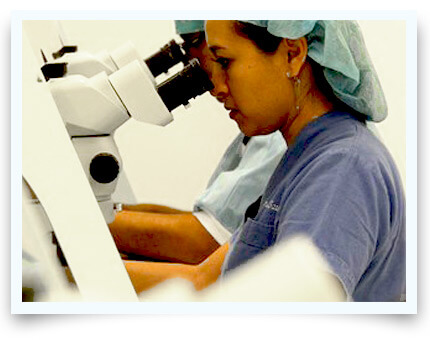Medical Preparation for your Egg Donor and Surrogate
There are two options for your upcoming embryo transfer, and which option you choose will effect how the donor and surrogate are prepared for the procedure.
Fresh Embryo Transfer:
Fresh Embryo transfer is when the embryos are transferred to your surrogate directly after the IVF procedure. This is somewhat complicated because the surrogate must be ideally prepared at the same moment as the embryos are ideally developed. It’s quite a feat of coordination (which is why many clinics prefer the second option).
It takes 6 to 8 weeks to fully prepare your egg donor and surrogate. The treatments are in two parts. The first month is required to synchronize the two women’s menstrual cycles. This is done with simple oral contraceptives, which suppress the normal cycle. During this time donors and surrogates are often on nutritional supplements such as Folic Acid to improve their overall fertility and the healthy of their ovaries and follicles.
 Donors and surrogates can be on Active Pill for many weeks (or even months). If your surrogacy clinic has their donor already on the pill, they can begin the donation/surrogacy preparation faster, and your procedure can happen with less than the typical 6 – 8 week delay.
Donors and surrogates can be on Active Pill for many weeks (or even months). If your surrogacy clinic has their donor already on the pill, they can begin the donation/surrogacy preparation faster, and your procedure can happen with less than the typical 6 – 8 week delay.
When both women stop taking the oral contraceptive, their menstrual cycle will begin again following a predictable 4-day delay. This is how the donor and surrogate cycles are synchronized. Once the donor’s cycle has begun, fertility injections by the clinic will mature the follicles in her ovaries so that the IVF doctor can retrieve them. The retrieval will occur on (or near) the 15th day of the donor’s cycle.
If a friend or family member is serving as your egg donor, then she will need to follow the same protocols as described above. She should be on continuous Active Pill for a minimum of 22 days. Then when her period resumes, she will begin 15 days of stimulation injections. She can have all these injections given at the surrogacy clinic. Or if you are having your procedure overseas, she can have the first 7 days of the injections at a local clinic and then travel aboard for the final 8 to 9 days of treatments prior to the donation. Either way, stimulation injections need to be made under the supervision of a physician.
Meanwhile, two weeks before the embryo transfer, the surrogate will also restart her menstrual cycle, and the clinic will administer injections designed to increase her receptivity to the transferred embryo(s). The success of her receptivity is often measured in the thickness of her endometrial layer, which is the lining of the uterine wall in which the embryos will lodge and develop into a fetus. An endometrial scan will show the results and determine the suitability of your surrogate. If the endometrial layer is not adequate, the clinic should recommend a different surrogate if possible (although this may not be possible in some countries).
Frozen Embryo Transfer
In a Frozen Embryo Transfer all of the embryos are immediately frozen after your IVF procedure. This allows the clinic some freedom in their preparation of the surrogate. Many clinics argue that this additional freedom to fully prepare the surrogate improves her receptivity and also the likelihood of pregnancy. There is significant debate in the medical community about which approach is best. However there is no doubt that a Frozen Transfer is significantly simpler to coordinate and can avoid a lot of headaches.
During a Frozen Transfer, the first month of oral contraceptives to synchronize the two women’s menstrual cycles is completely skipped. The egg donor will start fertility injections on the start of her natural cycle. These daily injections will mature the follicles in her ovaries so that the IVF doctor can retrieve them. The retrieval will occur on (or near) the 15th day of the donor’s cycle.
Immediately after donation, the embryos are fertilized and allowed to develop for 5 days. Then on the 5th day, when the embryos reach “Blastocyst” stage, they are all frozen and put into storage for a future transfer to your surrogate. Newer techniques of vitrification of the embryos have made freezing relatively harmless. Successful thaw rates of frozen embryos is over 90%, so you don’t need to worry much that the freezing process may damage the embryos.
Once the embryos are frozen, the clinic will turn it’s attention to the preparation of your surrogate. At the start of her natural cycle, and the clinic will administer daily hormone injections designed to increase her receptivity of her uterus. By day 15 of her cycle, she should be well prepared. At that time the best of your embryos are thawed and transferred to her uterus. The pregnancy test is administered 12 days later.
About the authors
Didn`t find what you need?
Search our complete library for all the answers...
...or return to the ‘Sensible’ Surrogacy Guide.
